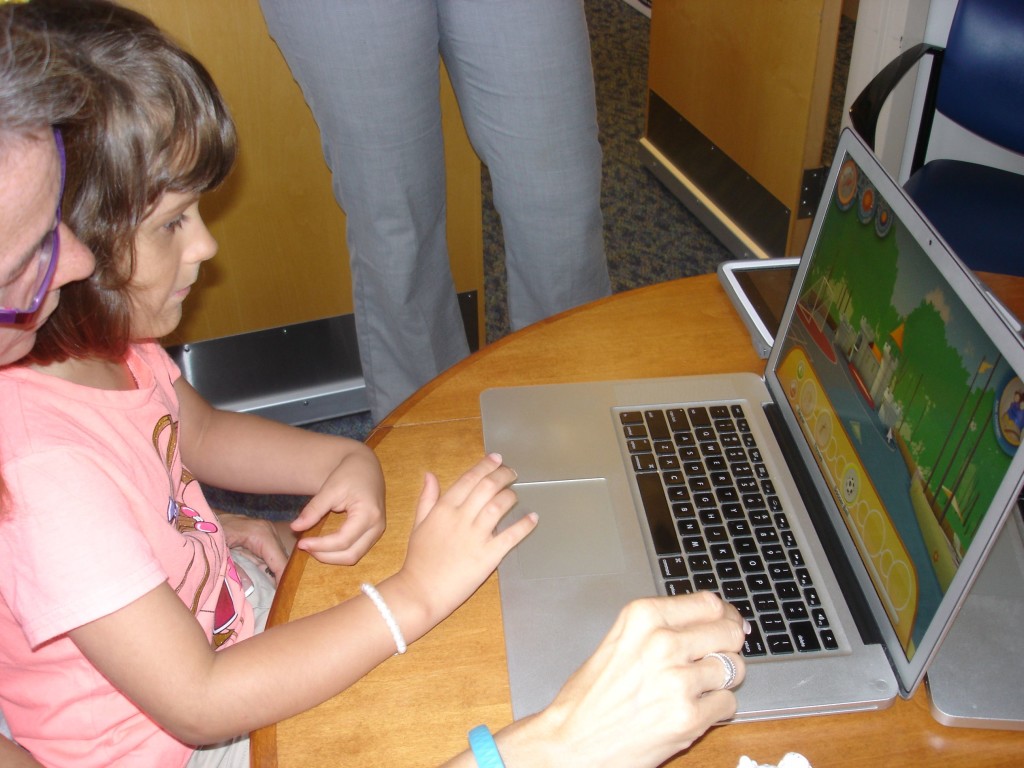
With initial help from her mother, Kailee West, 6, quickly masters the basics of Puddingstone Place, an interactive virtual environment that helps children with autism develop language skills.
In the 1990s, Facilitated Communication (FC), in which assistants “facilitate” the typing of thoughts by minimally verbal children by supporting their hands, began raising hopes in the autism community. The unproven procedure caught fire, and Syracuse University established a nationally recognized Facilitated Communication Institute.
Upon closer examination, though, doubts emerged. The messages were surprisingly sophisticated and written by children who often were not even looking at the keyboard. Critics charged that the words were actually those of the facilitator rather than the patient. Studies and organizations began discrediting FC.
In a 1993 PBS “Frontline” piece, Howard Shane, PhD, of Boston Children’s Hospital, conducted an experiment in which an autistic child was given a picture and asked to describe it. She typed words describing not the picture she was being shown, but a picture that only her “facilitator” could see.
In 1994, the American Psychological Association called FC “not a scientifically valid technique” and a “threat” to “civil and human rights,” having patients make statements that were really those of the facilitator.
What a difference a couple of decades make.
The mobile revolution
Technological strides have changed the game, bringing us augmentative and alternative communication (AAC) via mobile devices, the iPad and other touchscreen tablets. And Shane, who now directs the Center for Communication Enhancement and Autism Language Program at Boston Children’s, sees great potential for the newer computer technology-assisted advances to help the estimated 1 out of 68 children currently on the autism spectrum, as well as adults.
Now, instead of having to type a message on a keyboard, as with FC, users can touch a picture unaided and hear a voice express a word or phrase they cannot otherwise vocalize. A “60 Minutes” segment features scenes in which nonverbal children and young adults reveal their thoughts, feelings and knowledge for the first time—through a tablet or touchscreen computer they operate on their own.
Language practice
At a recent patient visit, Shane shows 6-year-old Kailee West the basics of Puddingstone Place, an interactive virtual environment developed by his team to assist with language skill development. Kailee has been working on prepositions and pronouns—hard parts of speech for children with autism to learn—so Shane guides her to the “who, what and where” part of the program. Kailee quickly gets the hang of choosing a character (who), an action (what) and a place in the house (where), making her character jump in the kitchen:
“We use the visuals as a gateway to speech,” Shane explains. “Our focus is helping children learn how to connect concepts together.” Soon Kailee is making sentences like “Skylar throws ball over swings” with minimal prompting, clicking a button to hear the words out loud:
“Her speech has improved immensely, and her self-stimulation has come down,” says LeighAnn West, Kailee’s mother. “She used to flap her arms a lot, but she doesn’t do that much anymore.”
Unlike FC, the benefits of the new apps and programs are documented by evidence, such as a recent three-year UCLA study of 61 minimally verbal autistic children, 5 to 8 years old. Researchers found language skills improved most significantly with a blend of spoken communication therapy and speech-generating touchscreen tablet applications. The authors noted “improvements in spontaneous communicative utterances, novel words and comments.”
Using the app in a social context, with a family member or therapist, was crucial “to the ability of children to connect words and actions in natural contexts,” the researchers noted, adding that some subjects even commented on what they were doing or thinking.
“The technology has an impact on nearly all of the patients we see, offering a way to express themselves, learn cognitive or language concepts or receive reinforcement,” says Shane.
Among Shane’s favorite programs are AutisMate, which uses visual supports to help children attain social and life skills, and Proloquo2Go, used in the UCLA study, with which users can “speak” by touching one of 14,000 symbols or photos. Kailee also uses an app called Pixwriter, which lets her write sentences by selecting visual images, including special pictures illustrating “over” and “under,” for example.
Normalizing devices
There’s something in the technology, says Shane, that attracts children “for reasons we don’t always understand. It is a tremendous magnet. It pulls them in.”
And the colorful, easy-to-use devices are “more affordable, more normalizing,” than previous large and stigmatizing machines that would travel with students in classrooms. Plus, “they offer a huge variety of programs,” Shane says.
A recent NPR segment, for example, featured a Queens, N.Y., high school band, whose disabled members use traditional instruments as well as iPads with musical apps including Thumb Jam. Several have autism and were previously nonverbal, but at least one now is even singing in the band. Director Adam Goldberg described how his students have advanced, socially as well as musically, and even greet one another each day.
Other emerging apps include games challenging children to read facial expressions and interpret social cues.
The potential for technology to broaden the worlds of people on the autism spectrum is reviving hopes that were crushed by the disappointing FC episode. But not all apps are created equal: Autism Speaks maintains a web page listing more than 500 apps by purpose, platform (Windows, iOS, Android), targeted age group and the extent of supporting research, inviting users to rate them. Autism Apps, developed by Touch Autism, provides a comprehensive, categorized list of apps that links to online videos and reviews.
Patty Morin Fitzgerald is a writer/editor living in the Boston area. She can be reached at [email protected].






